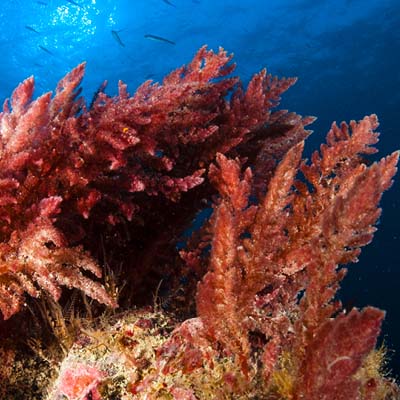PROUDLY SUPPORTED BY FEEDWORKS
Mission methane: More food companies turn to feed additives to reduce carbon footprint
This feature article has been extracted from its original version written by Lisa Held for Fortune Magazine.

At the agriculture industry’s biggest conference on sustainability in November 2021, Kelly Bengston, a senior vice president at Starbucks, said the company formed a new partnership in 2021 to begin to source milk from cows fed Agolin, a Swiss-made feed supplement (supplied in Australia by Feedworks) derived from essential oils, to help reduce its methane emissions.
Starbucks, which has invested more than $100 million in various efforts over the past few years to reduce the environmental footprint of its dairy supply, is just one of a growing number of global food companies that are stepping up their efforts to reduce emissions by utilizing feed additives—namely Agolin, Bovaer, or red asparagopsis (seaweed).
“We set our 2030 goals based on an assessment of our environmental impact across our global operations and supply chain, which provided a clear starting point and a guide for where to go,” Bengston said. “It also became clear that in order to reach resource-positive goals and protect our planet, we must innovate and collaborate. Nestlé joined forces with one of its suppliers, Barry Callebaut, in 2019 to work on integrating Agolin into its dairy supply chain as part of its effort to reach net zero by 2050.
When Agolin is fed to cows they produce less methane. Methane is produced by cattle through enteric fermentation and is about 28 times more powerful than carbon dioxide at warming the planet over a 100-year period. Agolin works by improving the overall efficiency of the fermentation process in the rumen.
Still, the science on how effective feed additives are and how they compare is still emerging, and major hurdles related to production and regulatory frameworks remain. At the same time, New Zealand researchers are working on developing vaccines that can prevent methane production from cattle, which could be crucial for cows on pasture. Several other methane mitigating solutions have been trialed already in Australia, including the use of some legume species, in addition to a range of other supplementary cow feed options.
[Feed additives] are important tools in our toolbox but they will not be the only ones
“[Feed additives] are important tools in our toolbox but they will not be the only ones,” said Frank Mitloehner, a scientist at the UC Davis Department of Animal Science who is at the forefront of research on reducing methane emissions from livestock.
Right now, Agolin is ahead of Bovaer and red asparagopsis in the marketplace in many ways, he said. It’s the first feed additive that’s widely available, and an estimated 1.3 million cows in Europe and the United States now ingest it alongside their silage. An on-farm study Mitloehner published in December 2020 found giving the supplement to dairy cows reduced the intensity of methane emissions by about 11%, and other studies have shown similar or better reductions. Mitloehner said his study was the most controlled to date, and as a result, he felt confident the results could be consistently replicated. And not only is Agolin currently available to farmers, it’s cost effective at about 3 to 5 cents per cow per day—and has been shown to significantly increase feed efficiency, therefore boosting farmers’ bottom lines. Unlike red asparagopsis, it’s also simple to produce. “The bottom line is that Agolin is the here and now,” said Ogorzalek. “It’s easy, it’s low-cost, and importantly, we’ve proven that on a commercial level, it makes farmers more money.”
Others in the industry are choosing to direct their dollars toward feed supplements that could cut methane in beef and dairy cattle at much higher rates compared to Agolin. There are dozens of peer-reviewed publications that back up the fact that Bovaer could reduce enteric methane between 30% and 90%. “The stuff works, we know it works, and if you wanted to produce it in mass, you could,” Mitloehner said.
The reductions are significant and consistent enough that in a recent report on transitioning Denmark to carbon-neutral agriculture, World Resources Institute researchers recommended dairy producers immediately test large-scale implementation as soon as Bovaer is approved. So far, Bovaer has been approved for use only in Brazil and Chile, but regulators in the European Union oved it one step closer to approval in mid-November. In the U.S., the Food and Drug Administration evaluation process is notoriously slow. In Australia, Bovaer is being trialed in feedlot beef but it is not currently registered for use here.

Mitloehner said it’s “far from being market-ready,” especially considering several unanswered questions. The biggest are around whether cows will eat it at a rate that does not reduce feed efficiency too much, and how to grow and process the amount that would be necessary to make a difference at a large scale.
Tom Shields, an investment partner at AgFunder (a venture capital firm dedicated to sustainable agriculture technology and innovation) acknowledged those challenges but said that “those things are being worked on in parallel by a bunch of really smart people,” and the potential is so great, it’s worth reaching for. Lab studies have shown potential methane reductions of up to 99%, and recent trials have shown average emissions reductions of over 50%.
“We’re investing in the solutions that are going to win overall in the marketplace over time,” he said, but he also didn’t think that meant Agolin and other faster-to-market additives didn’t have a role to play in the meantime. “It’s such a big problem that all of these solutions are needed.”